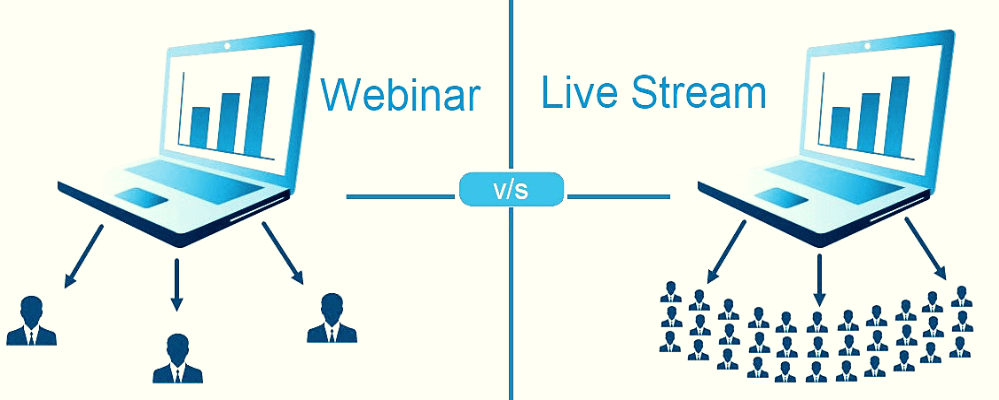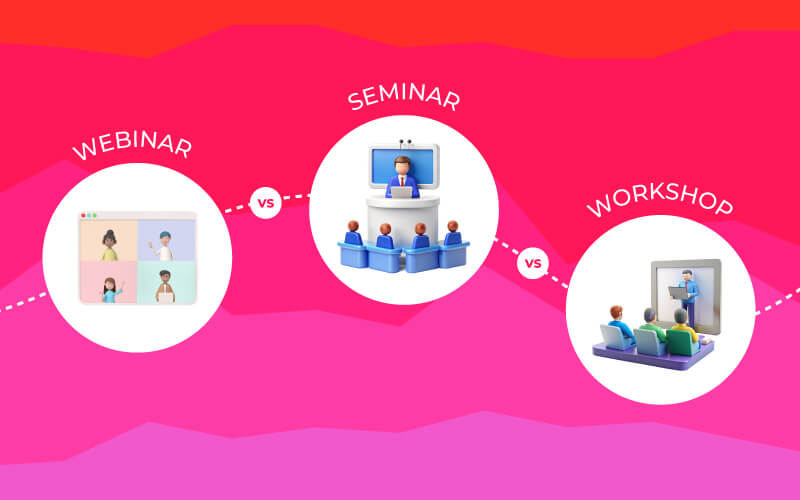The word, “webinar” consists of two separate words – web and seminar. It is pretty easy to understand the concept, which is a seminar that is hosted over the web.
A webinar can be either a live video webinar where live video is streamed to the audience which creates a more immersive and engaging experience or a webinar can be an on-demand webinar where the content is already pre-recorded.
In this blog, we’re going to take a look at webinars, webinar vendors, how they are used, the different types of webinars, and the most important features of a successful webinar.
What is a Webinar?
As mentioned above, webinars are essentially seminars over the web and most webinars you’ll find on the online webinar platforms follow the pattern of a seminar.
In fact, you can consider webinars to be the next step in the evolution of seminars. Whereas seminars had a lot of limitations, webinars allow people from all over the world to join, which increases reach and reduces costs for the webinar presenter. An on-demand webinar or a live webinar usually will have a presentation and a guest who talks about and discusses a predetermined topic. Webinars also often include presentations that are used to make the content easier to understand for the audiences. In the case of a live video webinar, the audience is given a chance to ask questions and discuss matters with the host and the guest for a short session after the presentation is over. Webinars are used in a variety of industries for a wide range of purposes. One of the major objectives of webinars is to establish a brand as a thought leader in their specific niche or industry.
Webinars For Marketing
One of the major uses of webinars is found in the world of marketing. Considering the cost of webinar services, most businesses find webinars to be a very cost-effective and reliable way of generating leads for their business.
A webinar allows a business to reach a wide range of people and webinar technology providers usually allow the host of the webinar to collect some necessary information from the audience before the start of the webinar.
This effectively makes webinars an excellent tool to collect data regarding potential leads for your business. By providing the audience with relevant and well-thought-out content, the value exchange makes sense for the viewer and the brand.
With social media live streaming picking up speed as being one of the most engaging ways of communicating with your online audiences, it only makes sense that webinars will continue to grow and prove to be an excellent and cost-effective method of lead generation.
Types of Webinar Used For Marketing
Webinar vendors provide tools to create a variety of webinars, and it is common to find webinars of all types being presented. Let’s take a look at some of the most popular types of webinars.
1. Expert Knowledge Sharing
One of the most typical types of webinars is educational webinars, where an expert on the topic is often invited to provide insights and advice that the audience can benefit from. The number of guests on the webinar can vary and some webinars even have groups of experts that provide advice on different aspects of the topic. Webcast vendors have ensured that their platforms are compatible with having multiple guests on the same webinar.
2. Product Demonstrations
Webinars are also a great way of promoting any product or service of businesses of all types. They are effective when it comes to sharing new features or even provide a demonstration of your best-selling product. As most consumers are visual-oriented, it makes more sense for them to make purchasing decisions based on a visual demonstration. When it comes to a live video webinar, the audience can ask further questions about the product which can help in providing more clarity about the best features of the product to the consumers.
3. Lead Nurturing Webinars
These webinars are designed to move the current prospects for any business further down the sales funnel. These webinars are often educational webinars that are used to establish the brand as a thought leader. It is not sufficient to think of these webinars as sales pitches. Instead, they should be thought of as case studies, live workshops, and thought leadership discussions that actually provide enough value to the consumer to make them want to buy the product or service offered.
4. Upkeep Webinar
While webinars are one of the best ways to get leads for your business, not all webinars are about getting leads. Some webinars can be used for other aspects of the business, such as customer onboarding and providing new ways of using their current products or services. Upkeep webinars are really meant to keep the customers of a business up to date with the latest developments of your business and products.
5. Webinar Series
A webinar series, as the name implies, is a series of webinars that usually follow a common theme or topic. A webinar series is a great way of building your audiences online as a lot of people can get hooked to catch up with the latest episode in the series. Webinar series, if done right, can be used to build a massive online audience and keep them hooked to your business, brand, or product.
6. Internal Webinar
Other than sales and marketing, webinars can also be used for internal purposes in a business. For example, webinars provide a great way to cover organization-wide meetings or events. They help in creating a better environment of communication and collaboration in most organizations.
7. Automated Webinar
Lastly, automated webinars are webinars that are automated. The content of these webinars is pre-recorded, and the webinar is usually on-demand streaming. These webinars are well-suited for presenting evergreen presentations that don’t need to be updated. While they are more convenient for both the host and the streamer, they also lack a few features that make webinars unique such as the engagement between the streamer and the audience.
Live Streams vs Webinar
Now that we have a fair idea of the different types of webinars that are most commonly streamed let’s understand the difference between a live stream and a webinar.
It is common to think of live streaming video and webinars as the same thing since both of them often use live video as the underlying technology. However, there are a few differences between live streams and webinars that are important to understand.

In a live stream, the quality of the video is given importance over everything else. In contrast, webinars are more about providing well-thought-out and researched content alongside the live video too. The quality of video in live streams is usually better when compared to the quality of video in webinars. This is because the bitrate in live video streaming platforms is generally higher than most webinar platforms.
On a broad level, live streaming is all about engagement while webinars are all about sharing verified information in a live manner to an online audience that can be spread across the globe.
Features Of The Webinar

Lastly, before we jump into the how of hosting a webinar on online webinar platforms, let’s take a look into some of the most important features for a successful webinar. While this list is a fairly basic one, we believe these three foundations are essential for any webinar to be effective and impressive at the same time!
1. Personal Touch
Just like in seminars, it is important for the audience to feel an actual connection with the presenter in order to really care about the content. You can use the best online webinar service but if your presentation lacks a personal touch, your webinar content will fall short of its mark. It can be a good idea to have a consistent format for your webinars and use your business branding in all webinars. This creates better recall value in the minds of the viewers. It is also important for the host to connect with the audiences and not seem as if he or she is reading a script.
2. Necessary Integrations
Webinar technology providers usually allow you to integrate tools that help in creating a more seamless experience for the viewer. Some of the necessary add-ons for a successful webinar include email and social media integration and analytics tools.
3. Engagement and Fun
A webinar is a great way to interact with your online audiences and when you do have their attention, it is important to ensure they stay engaged in order to ensure the webinar is effective. Some tools to make webinars engaging include live polls and surveys, screen shares, and interactive whiteboards.
Host Your Webinar Today With A Dedicated Live Streaming Partner
Hosting a webinar is an excellent way of generating leads and raising brand awareness for the business. However, there are a lot of different aspects that you need to take care of when it comes to hosting a webinar that is effective and engaging both.
Most brands and businesses use a dedicated live streaming platform that can provide excellent support while ensuring a low cost of webinar services.
Dreamcast can guide webinar live video streaming technology and services to create the most effective webinars for your brand and business.






